Breiðamerkursandur (Diamond Beach), Iceland
The Diamond Beach, known locally as Breiðamerkursandur, is one of Iceland’s most well-known natural wonders. Located along the southeast coast between Höfn and Vík, it sits near the mouth of the Jökulsá á Breiðamerkursandi River, where icebergs from the Jökulsárlón Glacial Lagoon meet the North Atlantic Ocean. These icebergs, originating from the Breiðamerkurjökull Glacier, a tongue of the mighty Vatnajökull Glacier, are carried by the river and deposited onto the striking black sands of the beach.
This constantly evolving landscape is a photographer’s dream. The glistening ice chunks, shaped by the elements, range in size from small gems to towering sculptures, their crystalline forms shimmering against the dark volcanic sand. Each visit offers a unique experience, as the arrangement, size, and number of icebergs change with the tides and weather conditions.
Easily accessible from the Ring Road (Route 1), the Diamond Beach is part of the Vatnajökull National Park, a UNESCO World Heritage Site. Whether you’re an avid photographer or simply seeking a surreal natural setting, the Diamond Beach is a must-visit destination that encapsulates the raw beauty of Iceland’s landscapes.

This article contains links to products and services that I think you will find useful. I may earn a commission on any purchases you make at no cost to you. As an Amazon Associate, I earn from qualifying purchases. Read more HERE
Breiðamerkursandur (Diamond Beach)
Just below Iceland’s famous Ring Road (Route 1), which separates Jökulsárlón Glacial Lagoon from the Atlantic Ocean, lies the breathtaking Breiðamerkursandur, better known as the Diamond Beach. Like many of Iceland’s black sand beaches, it is formed from volcanic ash and small pebbles, but this one is truly unique as its dark sands are adorned with sparkling icebergs.

The icebergs, born from the Breiðamerkurjökull Glacier, are carried from Jökulsárlón Lagoon down the Jökulsá á Breiðamerkursandi River and into the sea. Once in the ocean, the waves smooth and sculpt the ice into glittering forms before washing them ashore. This ever-changing process means that the beach constantly evolves, with new icebergs arriving on the tide while others are swept away. No two visits are ever the same.
The beach is divided by the river that flows from the lagoon, with icebergs often favouring one side depending on the tide and wind direction. To the east of the river, a small tidal island offers a haven for Arctic skuas and Arctic terns, whose acrobatic flights fill the skies above. These seabirds, busy tending their young during nesting season, add another layer of drama and life to the beach’s stunning natural scenery.

Wildlife at Breiðamerkursandur
Breiðamerkursandur is not only a paradise for photographers but also a hub of wildlife activity, offering opportunities to observe seals, birds, and even orcas in their natural environment.
Seals
The Jökulsárlón Glacial Lagoon and the river that connects it to the sea are teeming with wildlife, with seals being some of the most charismatic inhabitants. These playful marine mammals are often spotted fishing in the river’s strong currents or lounging on icebergs.
Winter months offer the best chance to see them, as they are more abundant during this time. In the summer, seal sightings become less frequent, but a few individuals can still be seen navigating the icy waters or basking near the lagoon.

Birdlife
Breiðamerkursandur is a fantastic location for birdwatching, particularly on the east beach, where an Arctic tern colony thrives.
These remarkable birds are famous for their agility and determination, often engaging in dramatic aerial acrobatics to defend their nests from predators like the Arctic skua, aptly nicknamed the “Pirates of the Sea” for their habit of stealing food from other birds.
While the Diamond Beach is home to many bird species, it’s not an ideal location for puffins, which prefer cliffs with sandy surfaces for burrowing. If you want to see puffins, the closest spots are the cliffs near Dyrhólaey Lighthouse and Reynisfjara Beach, both a few hours away along the south coast.

Orca
Although whale watching isn’t a primary activity here, the waters around Breiðamerkursandur are known to attract orcas (killer whales). These impressive predators patrol the coastline, hunting seals and fish that are abundant in the area. Spotting orcas from the beach is rare but not unheard of, especially during their seasonal migrations along Iceland’s south coast.
Photography at Breiðamerkursandur – How to Photograph the Diamond Beach
Breiðamerkursandur is a dream destination for photographers, with its dynamic interplay of shimmering icebergs and black volcanic sand creating endless opportunities for stunning shots.
Exploring the Beach
At first glance, the beach may appear as a chaotic mix of ice chunks and black pebbles, but patience and exploration reveal its hidden beauty. The further you venture from the car park, the quieter it becomes, making it easier to find pristine ice formations and compose your shots without interruptions.
Icebergs here range in size from enormous chunks to tiny, glittering pebbles, each offering unique photographic potential. Even on cloudy days, the contrasts between the dark sand and the ice make for dramatic images, while winter brings opportunities to capture the beach under a blanket of soft, diffused light.
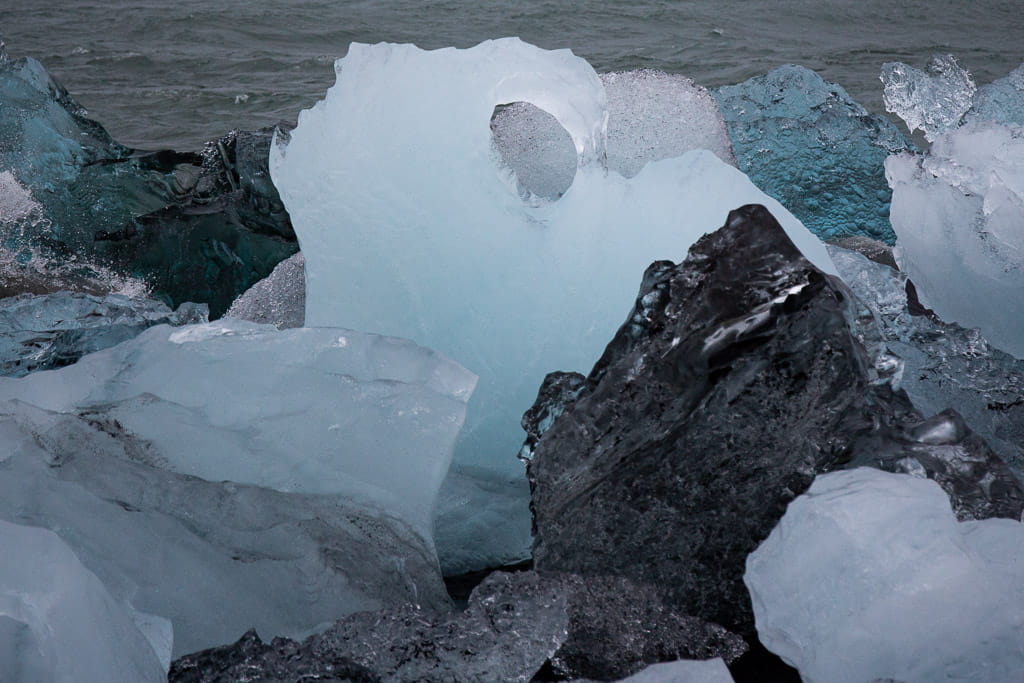
The Best Icebergs for Photography
Look for icebergs with vibrant blue or turquoise tones, as these colours pop beautifully against the black sand and contrast with the sky. Icebergs filled with volcanic ash tend to be grey and blend into the white surf, making them less visually striking. If you find the perfect iceberg, capture it quickly as it may be swept away or reshaped by the waves within moments.
Adapting to Weather Conditions
Weather on the beach can change rapidly, so adaptability is key. On calm days, you can photograph icebergs along the surf line, capturing their interaction with the waves.
During harsher weather, it may be safer and more practical to focus on ice formations washed higher up on the beach. Pay attention to interesting patterns, textures, and shapes within the ice, as the waves carve them into intricate, unique forms during their journey from the lagoon.

Beach Landscape
Capturing the beach landscape at Breiðamerkursandur is one of the simplest yet most striking ways to photograph this unique location.
The expansive stretch of black sand littered with glistening icebergs offers an unparalleled sense of scale and drama. For the best shots, try positioning yourself near the edge of the surf to capture the interplay between the beach, ocean, and ice. However, exercise caution, this is not always safe due to unpredictable waves and shifting ice.
Don’t forget to explore different perspectives. Walking west along the beach and looking back towards the car park often provides a fresh view, with the ice formations and distant figures offering a sense of perspective and scale.

Wave Patterns
With longer exposure times, you can capture the graceful retreat of waves as they flow around and between the icebergs, creating smooth, silky patterns in the surf.
These shots work best when the sea is calm, as rough waves will cause the ice to tumble and move unpredictably. To achieve this effect during daylight, use a neutral density (ND) filter to reduce light and extend your exposure time.
If the water is more active, shorter exposures can capture dynamic streaks and splashes in the surf. Both techniques offer a unique way to highlight the movement of water against the static ice.
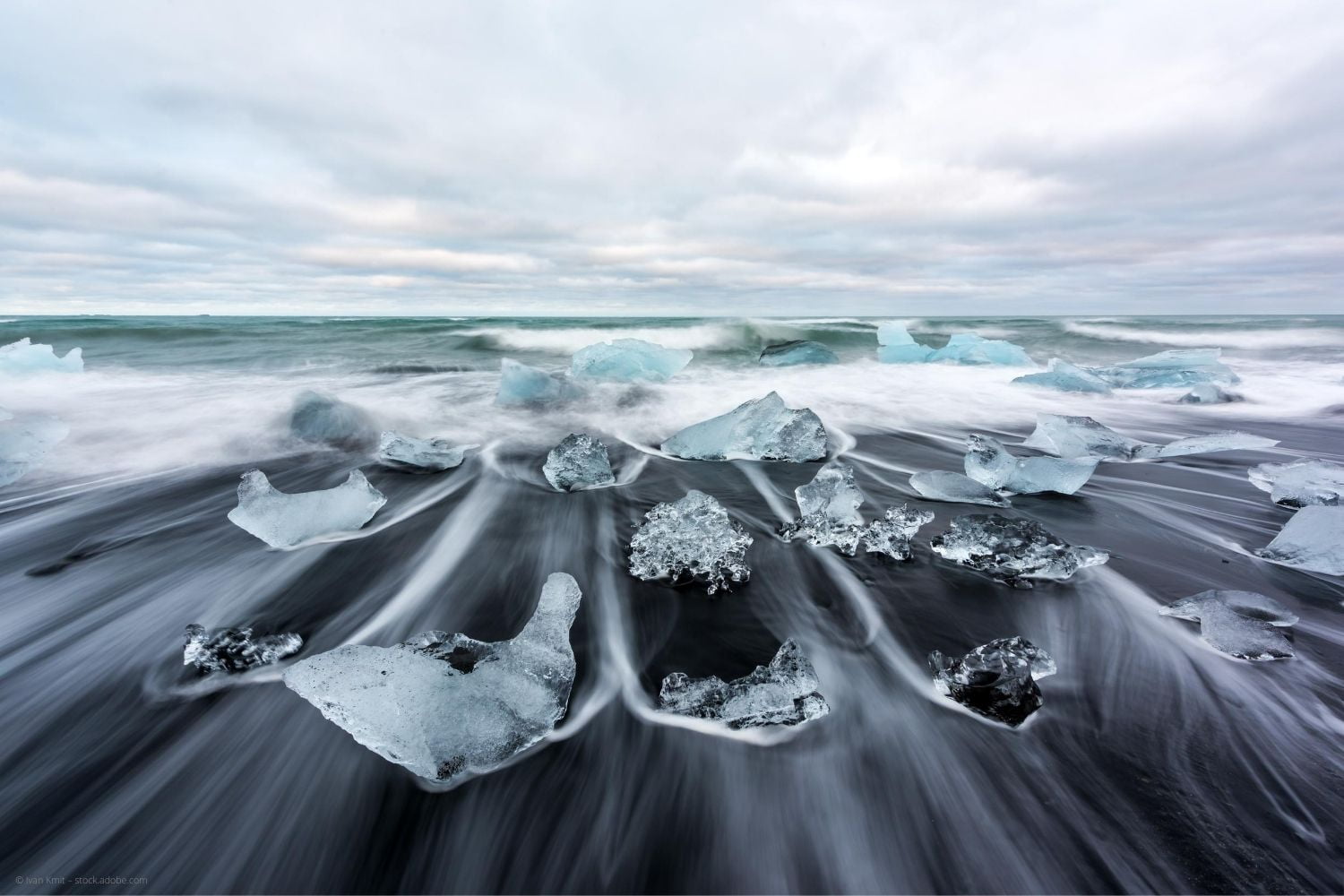
Splashing Waves
For days with rougher seas, focus on photographing the dramatic moments when waves crash over the icebergs.
Using a faster shutter speed will freeze the droplets mid-air, creating sharp, dynamic shots. Alternatively, a slightly longer exposure can blur the splashes into smooth, flowing lines for a more artistic effect.
Safety is paramount. Keep a safe distance from the surf, as sneaker waves can strike without warning, sweeping you or your equipment into the frigid ocean.
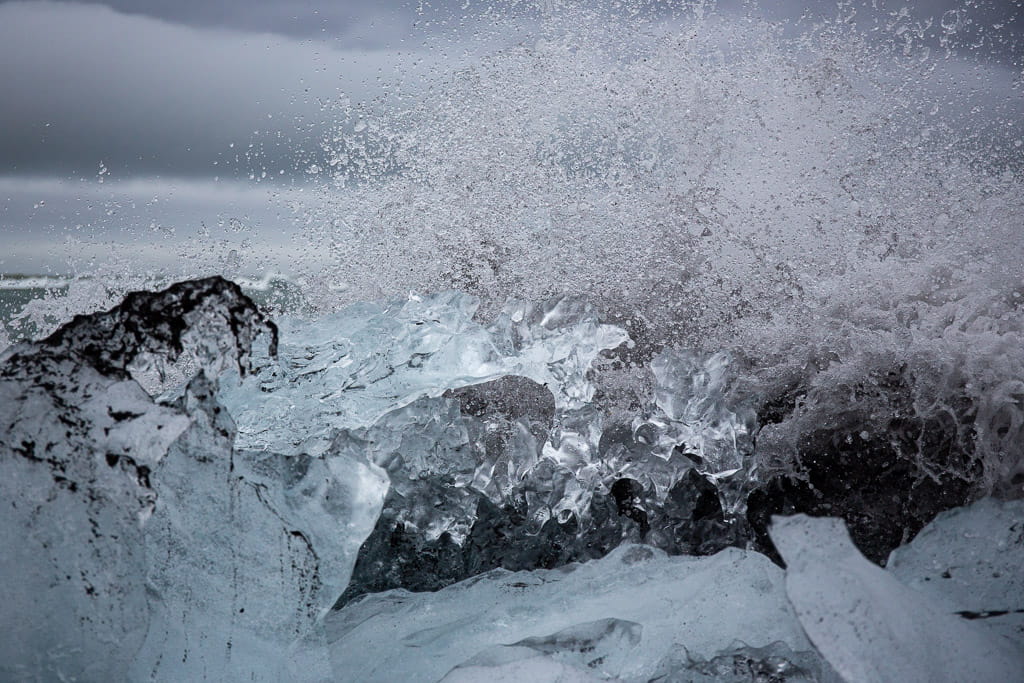
Ice Diamonds
Scattered across the beach are smaller chunks of ice, many of which resemble sparkling diamonds. Seek out pieces with interesting shapes and textures—hand-sized pieces can make for creative and playful shots.
Holding one of these “diamonds” against the backdrop of the ocean or sky can create striking compositions, especially during sunrise or sunset when the sunlight refracts through the ice, adding warmth and brilliance to your images.

Sunrise and Sunset at Diamond Beach
As a south-facing beach, Breiðamerkursandur is perfectly positioned to catch the golden light of sunrise and sunset. During the summer months, these events blend into one another, offering an extended window for photography.
In winter, although sunrise and sunset occur closer together, the low angle of the sun throughout the day creates dramatic lighting.
This is the ideal time to photograph the icebergs, as the soft, golden light enhances their colour and texture. Combine the light with longer exposures to capture smooth waves or use a high f-stop to create stunning sunbursts. Sunrise is particularly magical, with fewer visitors on the beach and a serene atmosphere for capturing the landscape.
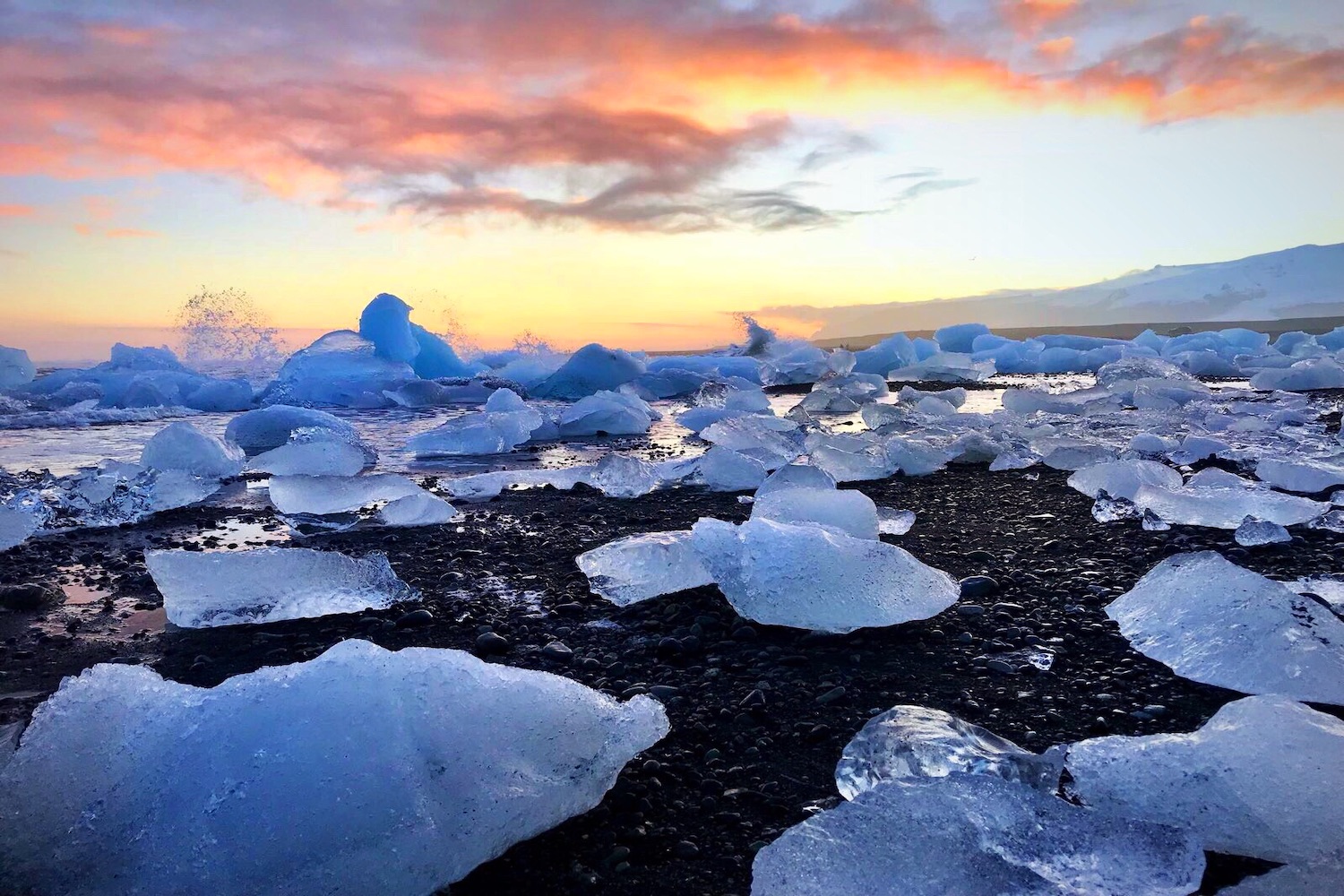
Aurora Borealis at Diamond Beach
Visiting during winter offers a chance to see the Northern Lights dancing above the ice. While the beach faces south, you’ll need to look back towards Jökulsárlón Lagoon or upwards for the best views if the aurora appears directly overhead.
Wide-angle shots work best here, incorporating the beach, icebergs, and aurora to showcase the surreal beauty of this spectacle.
Navigating the beach in the dark can be challenging—use a headtorch, dress warmly, and take extra care when walking near the water or ice.
Safety at Breiðamerkursandur
Safety is crucial at Breiðamerkursandur, as the beach’s natural beauty comes with inherent risks:
- Sneaker Waves: The Atlantic Ocean is unpredictable, and sneaker waves can appear suddenly, pulling people, cameras, and tripods into the freezing water. Always stay alert and keep a safe distance from the surf, especially during high tide.
- Shifting Ice: Large icebergs can move unexpectedly with the tide. Be aware of your surroundings and avoid standing too close to or between ice chunks, as they can shift or roll, posing a danger.
- Never Stand on Ice: Icebergs may look stable but are often slippery, unstable, and prone to movement. Standing on them is extremely dangerous, particularly as waves can sweep them back out to sea.
- Weather Preparedness: Even in summer, the beach is cold and exposed. Waterproof boots, insulated layers, and windproof clothing are essential to stay warm and comfortable. In winter, extra precautions are needed to protect against icy conditions and strong winds.

Best time of Year to Visit Breiðamerkursandur
Diamond Beach is a special destination that can be enjoyed throughout the year, with its glittering icebergs present regardless of the season.
Summer: During the summer months, the beach tends to attract more visitors, especially during the peak hours of the day. However, the long daylight hours provide the opportunity to visit late in the evening, when the crowds have thinned, allowing you to enjoy the beauty of the beach in relative solitude.
Winter: In contrast, winter offers a quieter experience, though reaching the beach can be more challenging. Snow, ice, and strong winds can make driving conditions difficult, so plan your journey carefully and prioritise safety. The beach itself is small and exposed, so dressing warmly and protecting yourself from the elements is essential.
Despite the colder conditions, winter holds its own unique charm. The short days mean that sunrise and sunset, arguably the most magical times to visit, occur at convenient hours and are often close together. This creates an extended window for exploring and photographing the beach under the enchanting golden light.
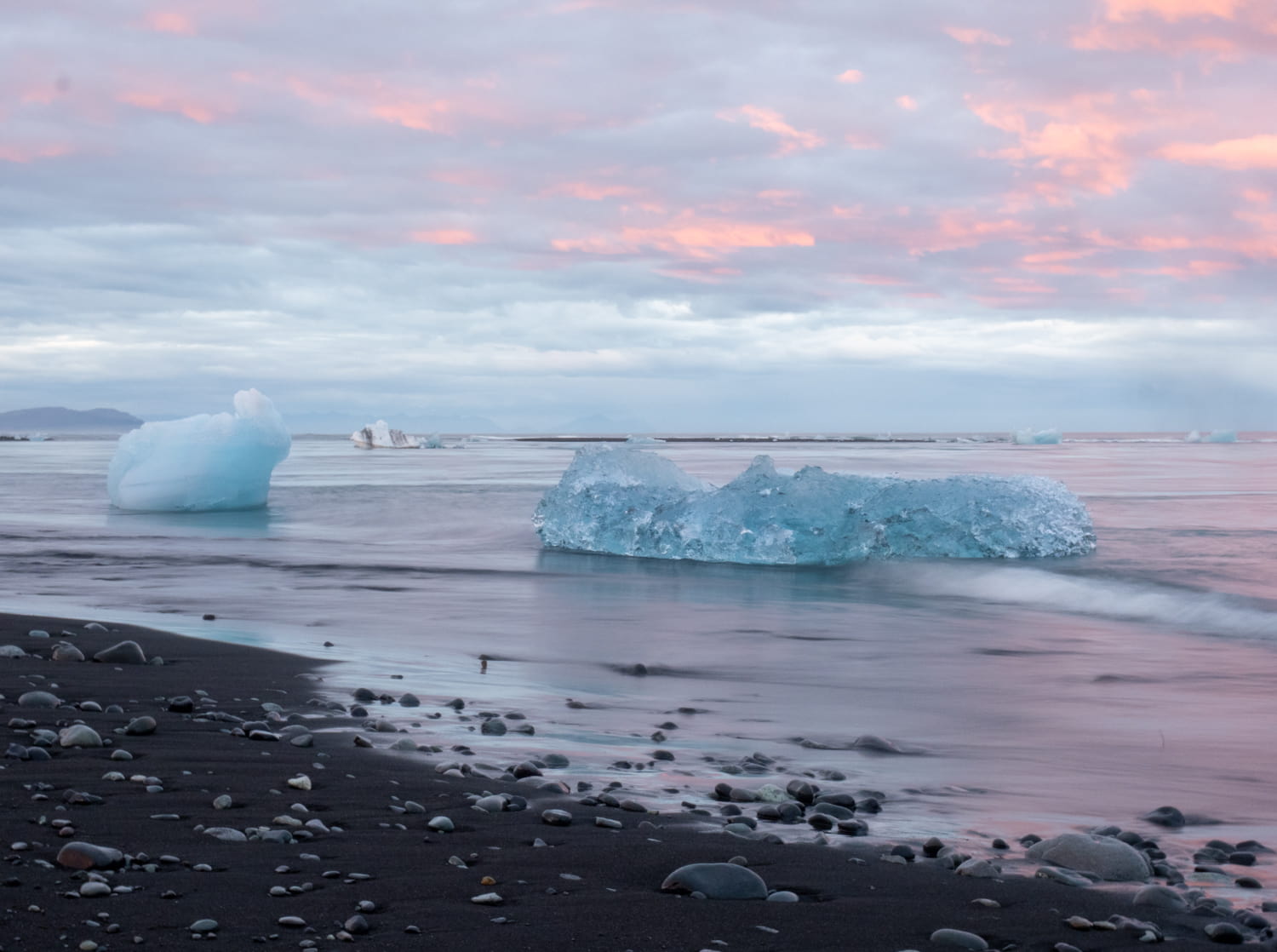
Getting to the Diamond Beach Iceland
Diamond Beach is located next to Jökulsárlón Glacial Lagoon, in the southeast of Iceland between Skaftafell and Höfn. The beach is easily accessible and offers free parking on both the east and west sides of the river that connects the lagoon to the Atlantic Ocean.
From the lagoon, access to Diamond Beach depends on where the icebergs have washed ashore:
- West Beach: Cross the bridge over the river and take the first left onto a gravel track. This bumpy road leads to a large parking area with direct access to the beach.
- East Beach: Leave the glacier lagoon car park and turn left, heading away from the bridge. After a short distance, you’ll see a turn on the right leading to a parking area with several information boards.
Distances and Travel Times
- From Reykjavík: Diamond Beach is 370 km away, about a 5-hour drive without stops. However, given the stunning scenery along the route, including many attractions, plan for a longer journey. In winter, shorter daylight hours and weather conditions can extend travel time. For these reasons, a day trip from Reykjavík is not ideal, and staying overnight nearby is recommended.
- From Höfn: The beach is just 60 km away, around an hour’s drive. Höfn is the nearest town with accommodation and services, making it a convenient base for exploring the area.
The proximity to Jökulsárlón Glacial Lagoon means you can easily combine a visit to both locations, making this one of the most popular stops along Iceland’s South Coast.
- Ring Road 1, between Skaftafell and Höfn
- Find on Google Maps
Tours to Diamond Beach
A variety of tours are available that combine the beach with nearby attractions like Jökulsárlón Glacial Lagoon or even adventures hiking on Vatnajökull Glacier or exploring the ice caves.
Guided tours offer the benefit of expert insights into the region’s unique geology, wildlife, and history, as well as the opportunity to safely explore the area, especially during winter when driving conditions can be challenging.
Tours include transportation from nearby towns like Höfn or even Reykjavík, making them a convenient option if you don’t want to drive.
Tours
Tours to Diamond Beach
Guided tours to Diamond Beach and Jökulsárlón Glacial Lagoon offer a seamless way to explore these locations, with expert guides providing fascinating insights into the region’s glacial history and unique features. Many tours include opportunities for photography, wildlife spotting, and even boat trips on the lagoon.
Where to stay
While there are no places to stay directly at Diamond Beach, several excellent options are available nearby to suit a range of preferences and budgets. From cosy guesthouses and family-run farms to modern hotels, the area surrounding Jökulsárlón Glacial Lagoon offers a variety of places to stay, all within a short drive of the beach. Staying nearby allows you to fully enjoy the stunning scenery, whether you’re visiting at sunrise, sunset, or even to catch the Northern Lights in winter.
FJALLSARLON
FJALLSARLON – OVERNIGHT ADVENTURE
This unique experience involves staying in a floating room on the glacier lagoon at Fjallsarlon, 11km west of Jokulsarlon Glacier Lagoon. The floating rooms have views to the glacier and the mountains surrounding the lagoon.
Jökulsárlón
Hótel Jökulsárlón – Glacier Lagoon Hotel
11km east of the Glacier Lagoon is Hótel Jökulsárlón – Glacier Lagoon Hotel. This larger hotel has beautiful views towards the glacier that looms in the distance. The hotel has hot tubs and a sauna to help you relax after a day of exploring. It is also well placed for the northern lights
Complete Guide to
ICELAND
Read all about Iceland, places to visit and the unique wildlife you may encounter
